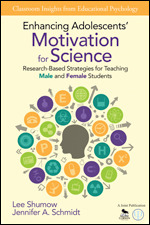Enhancing Adolescents' Motivation for Science
Research-Based Strategies for Teaching Male and Female Students
- Lee Shumow - Northern Illinois University, USA
- Jennifer A. Schmidt - Michigan State University, USA, Northern Illinois University, USA
Foreword by Shawn M. Glynn
Because motivation is the key to scientific literacy
Within every science classroom there are students waiting to be inspired. All these students need is the right motivation. That’s exactly what this one-of-a kind guide will help you provide. And along the way, you’ll quickly learn that the motivational tools that are most effective with adolescent boys don’t always work with adolescent girls—and vice versa.
At the heart of Enhancing Adolescents’ Motivation for Science is a collection of research-proven strategies on how best to motivate students in science—and once students are motivated, scientific literacy soon follows. Across chapters, Shumow and Schmidt
• Detail key motivational constructs specific to science with illustrative vignettes
• Address gender differences that influence how girls and boys are motivated
• Describe how to make science learning relevant, accessible, and enjoyable
• Reduce science anxiety and build student confidence, especially among girls
• Offer motivational strategies that are consistent with the Next Generation Science Standards (NGSS)
Much more than a professional book, Enhancing Adolescents’ Motivation for Science also includes a companion website packed with video clips, links, and tutorials. All in all, there’s no better resource for fueling the student motivation so central to science literacy.
“This is an impressive book. . . .One of the greatest challenges you face as a teacher is how to motivate all of your students—girls and boys—to learn science. In this book, Shumow and Schmidt help you to meet this challenge.”
— Shawn M. Glynn,
Josiah Meigs Distinguished Teaching Professor,
University of Georgia
“If you want to help your students succeed in science and could use some help achieving this goal, this book is for you. It is practical, driven by research, and has something for every science teacher to use.”
— Randy Cook, Science Teacher
Tri County Area Schools, Howard City, MI
“I was drawn into this book. I thought I was a motivating science teacher, but as I read, I saw new insights into my own classroom and my own students. I couldn’t wait to infuse ideas from the text into my everyday interactions with my students, especially the female students. My next step is to encourage my co-teachers to form a book study so that together we can create a positive force for supporting all students in STEM classrooms and choices for the future.”
“The book contains excellent strategies to motivate students in the classroom, along with resources that are useful to classroom teachers. After reading the chapters, teachers will be able to carry out the strategies in their classrooms the next day.”
“This book is one that every teacher would benefit from reading. There aren’t many other books out there that specifically deal with some of the issues in this book. It’s an easy read and provides teachers with follow-up materials or references.”
“If you want to help your students succeed in science and could use some help achieving this goal, this book is for you. It is practical, driven by research and has something for every science teacher to use.”
The authors effectively combined different topics to create a master plan on how to run a science classroom. After reading this important book, readers likely will conclude that science in the classroom is due a revival, and bringing it back begins with our nation’s youth. This book is a must-have on every teacher’s bookshelf.



